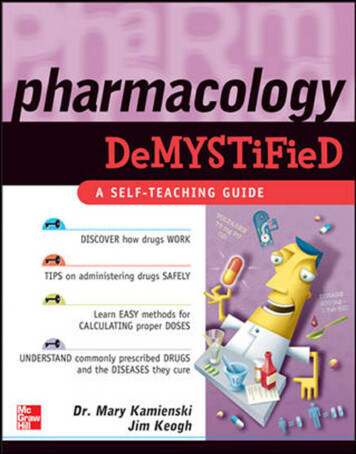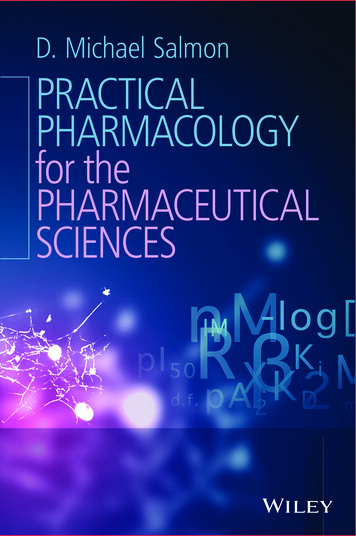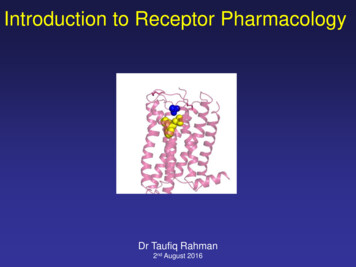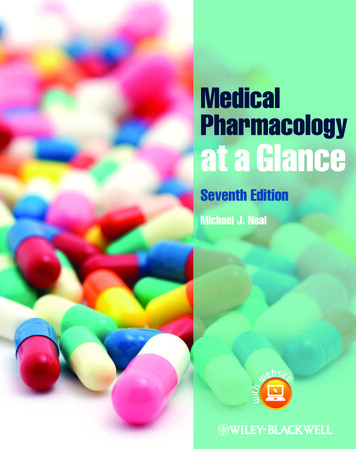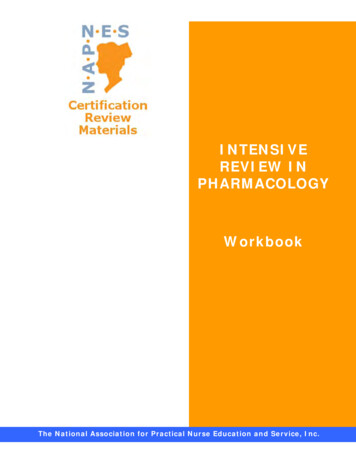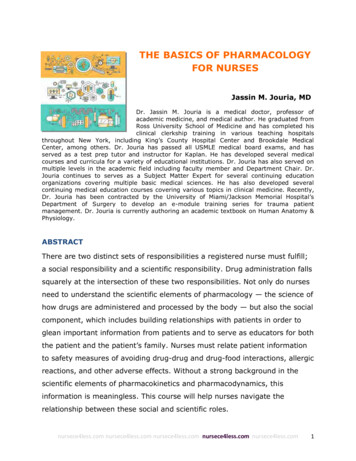
Transcription
A Textbook ofClinical Pharmacologyand Therapeutics
This page intentionally left blank
A Textbook ofClinical Pharmacologyand TherapeuticsFIFTH EDITIONJAMES M RITTER MA DPHIL FRCP FMedSci FBPHARMACOLSProfessor of Clinical Pharmacology at King’s College London School of Medicine,Guy’s, King’s and St Thomas’ Hospitals, London, UKLIONEL D LEWIS MA MB BCH MD FRCPProfessor of Medicine, Pharmacology and Toxicology at Dartmouth Medical School andthe Dartmouth-Hitchcock Medical Center, Lebanon, New Hampshire, USATIMOTHY GK MANT BSC FFPM FRCPSenior Medical Advisor, Quintiles, Guy's Drug Research Unit, and Visiting Professor atKing’s College London School of Medicine, Guy’s, King’s and St Thomas’ Hospitals,London, UKALBERT FERRO PHD FRCP FBPHARMACOLSReader in Clinical Pharmacology and Honorary Consultant Physician at King’s CollegeLondon School of Medicine, Guy’s, King’s and St Thomas’ Hospitals, London, UKPART OF HACHETTE LIVRE UK
First published in Great Britain in 1981Second edition 1986Third edition 1995Fourth edition 1999This fifth edition published in Great Britain in 2008 byHodder Arnold, an imprint of Hodden Education, part of Hachette Livre UK,338 Euston Road, London NW1 3BHhttp://www.hoddereducation.com 2008 James M Ritter, Lionel D Lewis, Timothy GK Mant and Albert FerroAll rights reserved. Apart from any use permitted under UK copyright law, this publication mayonly be reproduced, stored or transmitted, in any form, or by any means with prior permission inwriting of the publishers or in the case of reprographic production in accordance with the termsof licences issued by the Copyright Licensing Agency. In the United Kingdom such licences areissued by the Copyright licensing Agency: Saffron House, 6–10 Kirby Street, London EC1N 8TS.Hachette Livre’s policy is to use papers that are natural, renewable and recyclable products andmade from wood grown in sustainable forests. The logging and manufacturing processes areexpected to conform to the environmental regulations of the country of origin.Whilst the advice and information in this book are believed to be true and accurate at the date ofgoing to press, neither the authors nor the publisher can accept any legal responsibility or liabilityfor any errors or omissions that may be made. In particular, (but without limiting the generalityof the preceding disclaimer) every effort has been made to check drug dosages; however it isstill possible that errors have been missed. Furthermore, dosage schedules are constantly beingrevised and new side-effects recognized. For these reasons the reader is strongly urged to consultthe drug companies’ printed instructions before administering any of the drugs recommended inthis book.British Library Cataloguing in Publication DataA catalogue record for this book is available from the British LibraryLibrary of Congress Cataloging-in-Publication DataA catalog record for this book is available from the Library of CongressISBN978-0-340-90046-81 2 3 4 5 6 7 8 9 10Commissioning Editor:Project Editor:Production Controller:Cover Design:Indexer:Sara PurdyJane TodAndre SimLaura de GrasseJohn SampsonTypeset in 9/12 pt palatino by Charon Tec Ltd (A Macmillan Company) www.charontec.comPrinted and bound in ItalyWhat do you think about this book? Or any other Hodder Arnold title?Please visit our website: www.hoddereducation.com
This fifth edition is dedicated to the memory of Professors Howard Rogers and John Trounce,two of the three authors of this textbook’s first edition.
COMPANION WEBSITEThe fifth edition of A Textbook of Clinical Pharmacology and Therapeutics is accompanied by anexciting new website featuring the images from the book for you to download. To visit thebook’s website, please go to www.hodderplus.com/clinicalpharmacology.Your username is: student009Your password is: pharma
CONTENTSFOREWORDPREFACEACKNOWLEDGEMENTSPART I GENERAL PRINCIPLES1234567891011121314151617Introduction to therapeuticsMechanisms of drug action (pharmacodynamics)PharmacokineticsDrug absorption and routes of administrationDrug metabolismRenal excretion of drugsEffects of disease on drug dispositionTherapeutic drug monitoringDrugs in pregnancyDrugs in infants and childrenDrugs in the elderlyAdverse drug reactionsDrug interactionsPharmacogeneticsIntroduction of new drugs and clinical trialsCell-based and recombinant DNA therapiesAlternative medicines: herbals andnutraceuticalsPART II THE NERVOUS SYSTEM1819202122232425Hypnotics and anxiolyticsSchizophrenia and behavioural emergenciesMood disordersMovement disorders and degenerative CNSdiseaseAnti-epilepticsMigraineAnaesthetics and muscle relaxantsAnalgesics and the control of painPART III THE MUSCULOSKELETAL SYSTEM26 Anti-inflammatory drugs and the treatmentof arthritisPART IV THE CARDIOVASCULAR SYSTEM27 Prevention of atheroma: lowering plasmacholesterol and other approaches28 Hypertension29 Ischaemic heart disease30 Anticoagulants and antiplatelet drugs31 Heart failure32 Cardiac 97103105110116124133142145155165PART V THE RESPIRATORY SYSTEM33 Therapy of asthma, chronic obstructive pulmonarydisease (COPD) and other respiratory disordersPART VI THE ALIMENTARY SYSTEM34 Alimentary system and liver35 Vitamins and trace elementsPART VII FLUIDS AND ELECTROLYTES36 Nephrological and related aspectsPART VIII THE ENDOCRINE SYSTEM373839404142Diabetes mellitusThyroidCalcium metabolismAdrenal hormonesReproductive endocrinologyThe pituitary hormones and related drugsPART IX SELECTIVE TOXICITY434445464748Antibacterial drugsMycobacterial infectionsFungal and non-HIV viral infectionsHIV and AIDSMalaria and other parasitic infectionsCancer chemotherapyPART X HAEMATOLOGY49 Anaemia and other haematological disordersPART XI IMMUNOPHARMACOLOGY50 Clinical immunopharmacologyPART XII THE 2333434035136136738738939739940951 Drugs and the skin411167PART XIII THE EYE42117552 Drugs and the eye423177185196204211217PART XIV CLINICAL TOXICOLOGY43153 Drugs and alcohol abuse54 Drug overdose and poisoning433444INDEX451
FOREWORDJohn Trounce, who was the senior author of the first edition of this textbook, died on the16 April 2007.He considered a text in clinical pharmacology suitable for his undergraduate and postgraduate students to be an important part of the programme he developed in his department atGuy’s Hospital Medical School, London. It is difficult to imagine today how much resistancefrom the medical and pharmacological establishments Trounce had to overcome in order to setup an academic department, a focussed course in the medical curriculum and a separate examin final MB in clinical pharmacology. In other words, he helped to change a ‘non-subject’ intoone of the most important areas of study for medical students. He was also aware of the needfor a high quality textbook in clinical pharmacology that could also be used by nurses, pharmacists, pharmacology science students and doctors preparing for higher qualifications. (Forexample, it has been said that nobody knows more about acute pharmacology than ananaesthetist.)The present edition of the textbook reflects the advances in therapeutics since the publication of the fourth edition. It is interesting to follow in all the editions of the book, for example,how the treatment of tumours has progressed. It was about the time of the first edition thatTrounce set up the first oncology clinic at Guy’s Hospital in which he investigated the value ofcombined radiation and chemotherapy and drug cocktails in the treatment of lymphomas.John Trounce was pleased to see his textbook (and his subject) in the expert hands of ProfessorRitter and his colleagues.Roy SpectorProfessor Emeritus in Applied Pharmacology, University of London
PREFACEClinical pharmacology is the science of drug use in humans. Clinicians of all specialties prescribe drugs on a daily basis, and this is both one of the most useful but also one of the mostdangerous activities of our professional lives. Understanding the principles of clinical pharmacology is the basis of safe and effective therapeutic practice, which is why this subject forms anincreasingly important part of the medical curriculum.This textbook is addressed primarily to medical students and junior doctors of all specialties, but also to other professionals who increasingly prescribe medicines (including pharmacists, nurses and some other allied professionals). Clinical pharmacology is a fast movingsubject and the present edition has been completely revised and updated. It differs from thefourth edition in that it concentrates exclusively on aspects that students should know andunderstand, rather than including a lot of reference material. This has enabled us to keep itslength down. Another feature has been to include many new illustrations to aid in graspingmechanisms and principles.The first section deals with general principles including pharmacodynamics, pharmacokinetics and the various factors that modify drug disposition and drug interaction. We havekept algebraic formulations to a minimum. Drug metabolism is approached from a practicalviewpoint, with discussion of the exciting new concept of personalized medicine. Adversedrug reactions and the use of drugs at the extremes of age and in pregnancy are covered, andthe introduction of new drugs is discussed from the viewpoint of students who will see manynew treatments introduced during their professional careers. Many patients use herbal orother alternative medicines and there is a new chapter on this important topic. There is a chapter on gene and cell-based therapies, which are just beginning to enter clinical practice. Theremaining sections of the book deal comprehensively with major systems (nervous, musculoskeletal, cardiovascular, respiratory, alimentary, renal, endocrine, blood, skin and eye) andwith multi-system issues including treatment of infections, malignancies, immune disease,addiction and poisoning.JAMES M RITTERLIONEL D LEWISTIMOTHY GK MANTALBERT FERRO
ACKNOWLEDGEMENTSWe would like to thank many colleagues who have helped us with advice and criticism in therevision and updating of this fifth edition. Their expertise in many specialist areas has enabledus to emphasize those factors most relevant. For their input into this edition and/or the previous edition we are, in particular, grateful to Professor Roy Spector, Professor Alan Richens,Dr Anne Dornhorst, Dr Michael Isaac, Dr Terry Gibson, Dr Paul Glue, Dr Mark Kinirons,Dr Jonathan Barker, Dr Patricia McElhatton, Dr Robin Stott, Mr David Calver, Dr Jas Gill,Dr Bev Holt, Dr Zahid Khan, Dr Beverley Hunt, Dr Piotr Bajorek, Miss Susanna GilmourWhite, Dr Mark Edwards, Dr Michael Marsh, Mrs Joanna Tempowski. We would also like tothank Dr Peter Lloyd and Dr John Beadle for their assistance with figures.
PART IGENERAL PRINCIPLES
This page intentionally left blank
CHAPTER1INTRODUCTION TO THERAPEUTICS Use of drugsAdverse effects and risk/benefitDrug history and therapeutic plan334USE OF DRUGSPeople consult a doctor to find out what (if anything) is wrong(the diagnosis), and what should be done about it (the treatment). If they are well, they may nevertheless want to knowhow future problems can be prevented. Depending on the diagnosis, treatment may consist of reassurance, surgery or otherinterventions. Drugs are very often either the primary therapyor an adjunct to another modality (e.g. the use of anaestheticsin patients undergoing surgery). Sometimes contact with thedoctor is initiated because of a public health measure (e.g.through a screening programme). Again, drug treatment issometimes needed. Consequently, doctors of nearly all specialties use drugs extensively, and need to understand the scientific basis on which therapeutic use is founded.A century ago, physicians had only a handful of effectivedrugs (e.g. morphia, quinine, ether, aspirin and digitalis leaf)at their disposal. Thousands of potent drugs have since beenintroduced, and pharmaceutical chemists continue to discovernew and better drugs. With advances in genetics, cellular andmolecular science, it is likely that progress will accelerate andhuge changes in therapeutics are inevitable. Medical studentsand doctors in training therefore need to learn somethingof the principles of therapeutics, in order to prepare themselves to adapt to such change. General principles are discussed in the first part of this book, while current approachesto treatment are dealt with in subsequent parts.ADVERSE EFFECTS AND RISK/BENEFITMedicinal chemistry has contributed immeasurably to humanhealth, but this has been achieved at a price, necessitating anew philosophy. A physician in Sir William Osler’s day in thenineteenth century could safely adhere to the Hippocraticprinciple ‘first do no harm’, because the opportunities fordoing good were so limited. The discovery of effective drugshas transformed this situation, at the expense of very real risks Formularies and restricted listsScientific basis of use of drugs in humans44of doing harm. For example, cures of leukaemias, Hodgkin’sdisease and testicular carcinomas have been achieved througha preparedness to accept a degree of containable harm. Similarconsiderations apply in other disease areas.All effective drugs have adverse effects, and therapeuticjudgements based on risk/benefit ratio permeate all fields ofmedicine. Drugs are the physician’s prime therapeutic tools,and just as a misplaced scalpel can spell disaster, so can athoughtless prescription. Some of the more dramatic instancesmake for gruesome reading in the annual reports of the medical defence societies, but perhaps as important is the morbidity and expense caused by less dramatic but more commonerrors.How are prescribing errors to be minimized? By combininga general knowledge of the pathogenesis of the disease to betreated and of the drugs that may be effective for th
John Trounce, who was the senior author of the first edition of this textbook, died on the 16 April 2007. He considered a text in clinical pharmacology suitable for his undergraduate and postgradu-
